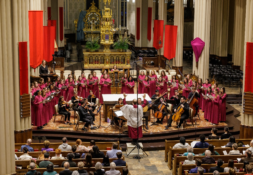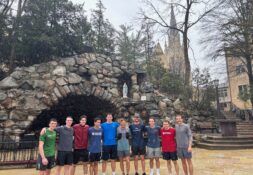The law school and the Gothic lexicon
As we return for the second half of the spring semester, I find myself increasingly reflective about my time at Notre Dame. I thus thought it would be appropriate to bring the subject of this column, which has recently covered topics as far afield as India and postmodernism, back to that of the very first column of Fall 2010. Loyal readers may recall that I began my architectural assessment of Notre Dame’s campus with the landmark buildings of South Quad.
In subsequent research, I discovered a likely source of inspiration for the law school building, which I would like to bring to public attention. The original portion of the law school was designed by the Boston firm Maginnis and Walsh and constructed in 1931.
While browsing the pages of Margaret Wood’s seminal sourcebook on THE ENGLISH MEDIEVAL HOUSE, I noticed a familiar-looking window from South Wraxall Manor in Wiltshire, England. It was nearly identical to those of the first floor of the law school. As Wood wrote, “At South Wraxall…the oriel chamber has a three-light [window] more perpendicular still, each mullion carried up to the main four-centered arch, with parallel bars rising from the apex of each cinquefoiled light; the panels so formed have trefoiled heads; above this a two-light to the closet has a square head with similar tracery on a smaller scale.” To break down this description, it helps to know a bit of the terminology of English gothic tracery.
The vertically-oriented stone tracery dividers which break the window into multiple lights are called mullions. Horizontal tracery is commonly referred to as a muntin, but in perpendicular gothic, where such divisions play a prominent compositional role, the term transom is often used. The largest lights in each window are known as superior lights, in the sense of major, not above. Smaller lights are called panels and occur almost exclusively above the topmost transom bar of the superior lights. In perpendicular tracery, these transom panels may be considered alternating or supermullioned, depending on whether their dividing bars extend from only the apex of the superior lights or from both the apex and the mullions below.
In the absence of a transom, as at the law school, the bottoms of these panels are defined by the raking extrados, or top edge, of the arching superior lights, resulting in a non-rectangular batement light. The ornamental cusps on the intrados, or inner edge, of the superior and batement lights are classified by number – on the law school, they are cinquefoil (5) and trefoil (3), respectively.
South Wraxall Manor was built around the year 1435, and the tracery is characteristic of the work of master craftsman William Wynford, which includes such projects as New College, Oxford (1380-86) and Winchester Cathedral (1394). South Wraxall’s oriel window is spanned by a “four-centered” arch which was very much in vogue at the time. Four-centered refers to the fact that the curvature of the arch is constructed from four different points with two symmetrical radii. In the only significant deviation from its model, the law school simplifies this by employing a surbased, two-centered arch beneath segmental archivolts between buttresses.
In another chance discovery, I found a detailed entry on South Wraxall Manor in Peter Mandler’s THE FALL AND RISE OF THE COUNTRY HOUSE. What Mandler reported lends credence to my suspicion that it functioned as a model for the law school: “Unusually for a house of its size, South Wraxall was open to the public from 1854, having been deserted by its owners in 1817 and subsequently used as a school. In the 1870s, the few visitors were mostly graduates of that school revisiting their old haunts. But in the 1880s and 1890s, this small manor house with its beamed hall of the fifteenth century and its flamboyantly Elizabethan upstairs rooms took on a new interest. It was featured in the Art Journal in 1883, visited by parties of architects and archaeologists in 1887, guides were published in 1880 and 1893, and in 1904 it received the ultimate accolade of a COUNTRY LIFE profile…by the turn of the century [visitors] had topped one thousand a year.”
From this description, it is evident that accurate and detailed information about South Wraxall was widely published and available to architects as source material, and indeed was popularly promoted as such. Given the near-exact replication of its light arrangement – closer even than other works by Wynford himself – it seems certain that Maginnis and Walsh looked to this exquisite manor house for inspiration while designing the law school for Notre Dame.
Matthew Balkey is a fifth year architecture student who recently invented a new cocktail consisting of Grand Marnier, Amaretto, and Vanilla Coke. He is accepting suggestions to name this concoction at mbalkey@nd.edu.





